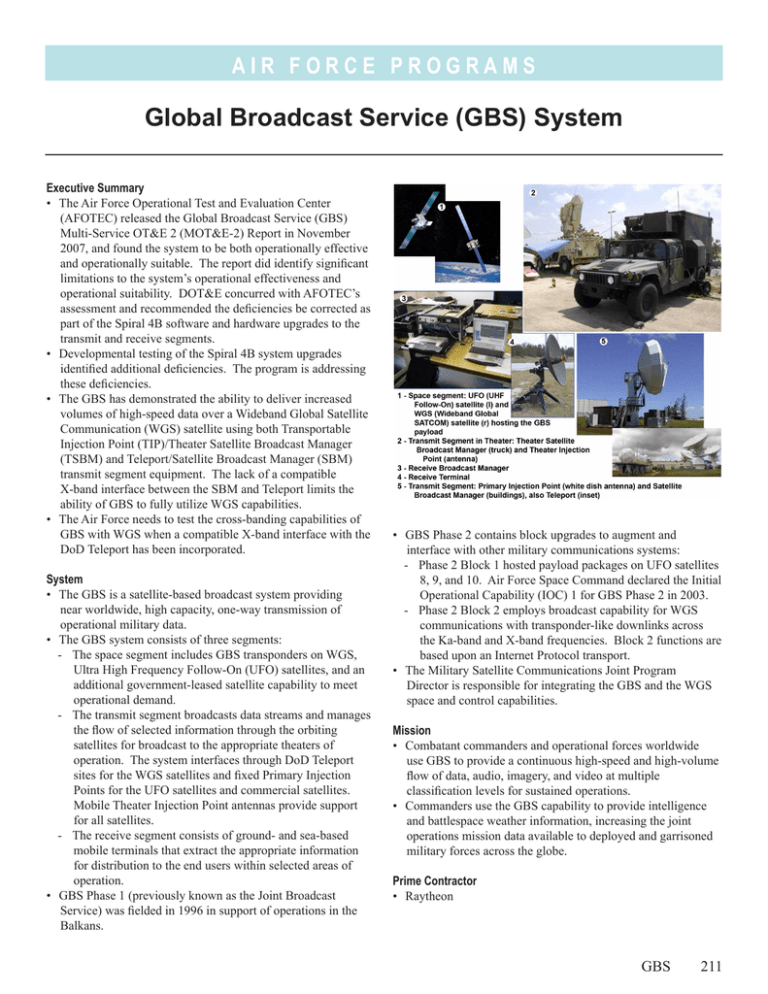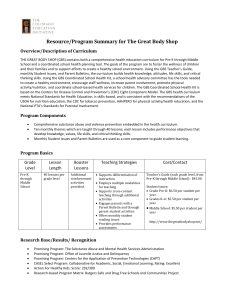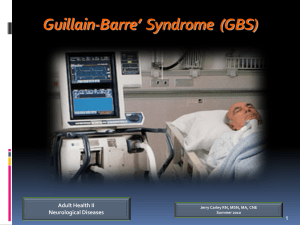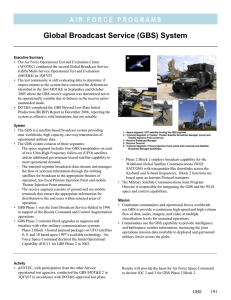Global Broadcast Service (GBS) System
advertisement

A i r F o r c e P RO G R A M S Global Broadcast Service (GBS) System Executive Summary • The Air Force Operational Test and Evaluation Center (AFOTEC) released the Global Broadcast Service (GBS) Multi-Service OT&E 2 (MOT&E-2) Report in November 2007, and found the system to be both operationally effective and operationally suitable. The report did identify significant limitations to the system’s operational effectiveness and operational suitability. DOT&E concurred with AFOTEC’s assessment and recommended the deficiencies be corrected as part of the Spiral 4B software and hardware upgrades to the transmit and receive segments. • Developmental testing of the Spiral 4B system upgrades identified additional deficiencies. The program is addressing these deficiencies. • The GBS has demonstrated the ability to deliver increased volumes of high-speed data over a Wideband Global Satellite Communication (WGS) satellite using both Transportable Injection Point (TIP)/Theater Satellite Broadcast Manager (TSBM) and Teleport/Satellite Broadcast Manager (SBM) transmit segment equipment. The lack of a compatible X-band interface between the SBM and Teleport limits the ability of GBS to fully utilize WGS capabilities. • The Air Force needs to test the cross-banding capabilities of GBS with WGS when a compatible X-band interface with the DoD Teleport has been incorporated. System • The GBS is a satellite-based broadcast system providing near worldwide, high capacity, one-way transmission of operational military data. • The GBS system consists of three segments: - The space segment includes GBS transponders on WGS, Ultra High Frequency Follow-On (UFO) satellites, and an additional government‑leased satellite capability to meet operational demand. - The transmit segment broadcasts data streams and manages the flow of selected information through the orbiting satellites for broadcast to the appropriate theaters of operation. The system interfaces through DoD Teleport sites for the WGS satellites and fixed Primary Injection Points for the UFO satellites and commercial satellites. Mobile Theater Injection Point antennas provide support for all satellites. - The receive segment consists of ground- and sea-based mobile terminals that extract the appropriate information for distribution to the end users within selected areas of operation. • GBS Phase 1 (previously known as the Joint Broadcast Service) was fielded in 1996 in support of operations in the Balkans. • GBS Phase 2 contains block upgrades to augment and interface with other military communications systems: - Phase 2 Block 1 hosted payload packages on UFO satellites 8, 9, and 10. Air Force Space Command declared the Initial Operational Capability (IOC) 1 for GBS Phase 2 in 2003. - Phase 2 Block 2 employs broadcast capability for WGS communications with transponder-like downlinks across the Ka-band and X-band frequencies. Block 2 functions are based upon an Internet Protocol transport. • The Military Satellite Communications Joint Program Director is responsible for integrating the GBS and the WGS space and control capabilities. Mission • Combatant commanders and operational forces worldwide use GBS to provide a continuous high-speed and high‑volume flow of data, audio, imagery, and video at multiple classification levels for sustained operations. • Commanders use the GBS capability to provide intelligence and battlespace weather information, increasing the joint operations mission data available to deployed and garrisoned military forces across the globe. Prime Contractor • Raytheon GBS 211 A i r F o r c e P RO G R A M S Activity • AFOTEC released the GBS MOT&E-2 Report in November 2007, and found the system to be both operationally effective and operationally suitable. The report did identify significant limitations to the system’s operational effectiveness and operational suitability. DOT&E concurred with AFOTEC’s assessment and recommended the deficiencies be corrected as part of the Spiral 4B software and hardware upgrades to the transmit and receive segments. • AFOTEC completed the final remaining GBS test objectives during the GBS portion of the WGS MOT&E in May 2008. Testing was conducted in accordance with DOT&E approved Test and Evaluation Master Plan (TEMP) and test plans. AFOTEC could not test these objectives until WGS was ready for MOT&E. • The test community is finalizing the AFOTEC WGS MOT&E Report. Results will be combined with those from the 2007 GBS MOT&E-2 to provide the basis for Air Force Space Command (AFSPC) to declare IOC for Phase 2, Block 2. • The program conducted developmental testing of the Spiral 4B changes to the system. This testing revealed additional deficiencies that are being corrected. • The Joint Staff deferred an IOC declaration by AFSPC due to information assurance concerns. The GBS program is taking the necessary remedial actions to address the Joint Staff’s concerns before declaring IOC. Assessment • Upon the completion of the MOT&E-2, DOT&E assessed the system as effective with limitations and suitable 212 GBS with limitations. The GBS receive suite terminals were operationally effective, but did not deliver the level of service and dependability required since the receive suites did not demonstrate the capability required while operated in the “unattended” mode. The GBS receive suite terminals were operationally suitable, but had reliability difficulties and information assurance deficiencies. These deficiencies are being corrected. • The GBS has demonstrated the ability to deliver increased volumes of high-speed data over a WGS satellite using both TIP/TSBM and Teleport/SBM transmit segment equipment. The lack of a compatible X-band interface between the SBM and Teleport limits the ability of GBS to fully utilize WGS capabilities. • The existing satellite constellation limits the coverage of GBS; however, this is being corrected as more WGS satellites become operational. Recommendations • Status of Previous Recommendations. The Air Force has made progress on the FY06 and FY07 DOT&E recommendations. Three of the seven FY06 recommendations and all of the FY07 recommendations remain valid. • FY08 Recommendation. 1. The Air Force should plan and conduct follow-on testing of the cross-banding capabilities of GBS with WGS when a compatible X-band interface with the DoD Teleport has been incorporated.






